The Butler Cattle
By Darol Dickinson
The story behind one of
the unique bloodlines in the
Texas Longhorn breed.
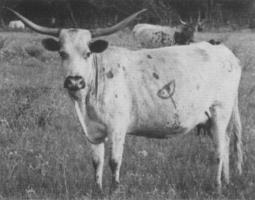
This six-year-old cow, owned by Wright Materials, is a daughter of a Butler cow purchased in an early TLBAA sale. |
"Get that heifer!"
"It's too late. She'll hit the brush in a minute."
"There goes that Butler kid!"
"He caught her!"
"That kid's a hand with a rope."
"He's sure a horseback, too."
"Whose brand goes on this one?"
"Yours does, Henry! For a catch like that - it's worth the price of a heifer just for the show." Thus, the first Henry Butler Longhorn female was acquired. The year, 1923. The new breeder, Henry Butler, age 10. The place, League City, Texas.
In the early twenties, cow trader, Perry McFadden, brought 10 to 15 thousand head of native east Texas cattle annually to the open range areas at League City. This tall grass, partially timbered, lowland area just south east of the present city limits of Houston was ideal for a fast economical gain. Several other early day cowmen took advantage of the same area and established the beginnings of vast cattle empires.
With the open range and moving cattle in and out, the annual round ups became the highlight of the year, especially for young Butler. From the first cow roped and branded to the last, several weeks later, Butler was right in the middle of it all. Very little money changed hands for round up work, especially for Henry. His pay came in heifers.
"I always picked out the big-horned ones," Henry says. In this way, year by year, a small select but growing herd of native east Texas Longhorns was assembled.
The Butler family have been residents of League City for several generations. During our interview with Henry, who is now 65-years-old, we drove down a beautiful main street and huge live oak trees stood towering above and hanging out over the street. "My grandpa planted those," he recalled. "The old ranch head quarters used to be there where that housing development is."
Milby Butler, Henry's dad, was involved in establishing some of the first registered Brahman cattle in the area. The introduction of these cattle to cross with native and English blood cattle was Milby's goal for many years during the middle of his lifetime. During these years, Milby paid little attention to Henry's Longhorns and directed his major efforts to the newly acceptable Brahman breeding program. Herds all over the south still proudly claim to have Butler Brahman blood as the nucleus of their best breeding stock.
Milby Butler's father, George W. Butler, had owned stock pens where the Butler Ranch joined the G.H. & H. Railroad. Tens of thousands of Longhorns came through the pens. During one period of time, 49,000 Longhorns were shipped to Cuba. The first year of the Cuban shipments, 29,000 head were exported. The cattle were always unloaded in the Butler stock pens on their way from Houston to Galveston.
George Butler owned a Longhorn slaughtering house. The skins and tallow were sold. Buttons were made from the horns. Meat was not that important due to storage limitations prior to refrigeration methods used today.
League City was Milby Butler's stomping grounds since birth in 1889. At first the post office of the community bore the name Butler Ranch - G.H. & H. The community that followed then adopted the name Clear Creek. The town that followed changed the name to League City. Milby once stated, "I've lived in three different towns in my life, but I've never moved."
Young Henry hated school. He wanted to be riding, roping and working cattle. During the 8th grade, he stuck it out until the first report card came home. After this, local old-timers say Henry still holds the record for playing hooky. Henry generally walked to school. If he walked, he never made it to school. If he was late getting ready, his mom took him. In that case he ran in the front door and out a side door, not being seen by school officials. When report card time came, Henry filled out the card, giving himself average grades. His parents signed the card and Henry supposedly returned it to the teacher.
The teachers didn't get too worried about the lack of attendance. Many of the local Italian ranchers kept their older kids out of school during round ups and harvest. This was not Milby's plan, however. Everything went okay with Henry's school avoiding program until one day Milby needed a hand with some cattle. He road up to the schoolhouse and asked for Henry to be excused for the rest of the day. The answer was - "We haven't seen Henry in months. We thought you were using him all the time."

Young cows owned by F.M. Graves, all of Butler breeding. |
After this, Milby enrolled him in the military academy at Bryan, Texas, where his attendance record became very consistent.
During the years prior to Henry's military service, he continued to increase the numbers of big-horned cattle. The origin of these cattle Henry says was, "Just old big-horned east Texas cattle. They were all over the country in those days." The Butler Longhorns in the 20's were all duns, reds, brownish and solid colors. The highly colorful cattle were virtually unknown as we see them today.
Prior to the 30's, it was not any trouble to acquire big-horned cattle in many parts of south Texas. There were thousands of different families of Longhorns from which to get new and different cows or bulls to maintain or improve a herd. As more Brahman and English blood was crossed on native cattle, the pure Longhorns became more scarce. In order to preserve Longhorn herds, a special effort had to be exerted to locate top blood.
In 1931, Butler traded Pat Phelps of Newton County two Brahman cows for a white "flea-bitten" Longhorn cow. This white speckled cow with red ears, red rings around the eyes and nose, and red specks on the ankles became the first source of the color trait many people refer to as "Butler color".
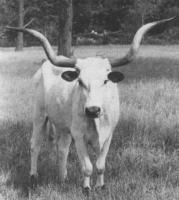
A 10-year-old Butler steer belonging to F.M. Graves of Dayton, Texas. |
M.P. Wright, III of Robstown, Texas said, "We bought some Butler cows in the first TLBAA sales. That white color with the red or black ears be came the most dominant color in our herd." About 5 percent of the Wright cattle possess that blood.
Henry described the "flea-bitten" cow as a medium sized cow with a double twist corkscrew horn shape.
Milby, in his search for outside Longhorn blood, purchased five cows from Esteben Garcia of Encino, Texas. These cattle were not the east Texas variety. They were true Mexican cattle. They came off a dry desert area and had been living on cactus most of their lives. They had calluses on their knees and hocks from getting up and down on rock and cactus. Their mouths were so full of pear spears that their muzzles looked like a porcupine's back.
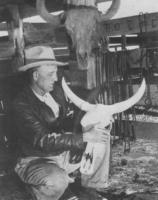
Milby Butler with Brahman skulls, about 1935. |
When the cattle were transported to League City, three died and two lived. These cows, although an entirely different bloodline, bore the Butler trait of huge horns with cork screw twists. One cow was red with a white star on the forehead. She gave birth to 12 bulls and no heifers. These sons were used for out-cross Longhorn blood on the original Butler herd. At one time, a fellow Longhorn enthusiast offered Butlers $2,000 for this cow, but didn't get to own her. That was when a cow would only bring $130 over the scales.
When the corkscrew horned cow died, Milby had her head mounted. "The head," I asked Henry, "where is it? I'd like to get a photo of it."
"Well, I gave it to a kid who is going to repair it and patch some places that came apart. It's in his barn, I think."
We went to see it. It wasn't in the barn. Next door lived Walter Wetzel, a Texas & Southwestern Cattle Raiser Assn. Field Inspector. We asked if he knew where it was. He said some hay haulers had stacked hay in the barn and no one had seen the head since they were there.
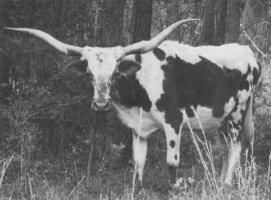
"Beauty" is the longest horned cow certified by TLBAA. She measures 58" tip- to-tip at age 17. Her twisted horn shape is typical of the best Butler cattle. She is owned by Pauline Russell of Liberty, Texas. |
In the early 60's, Milby borrowed a two-year-old wine and white speckled bull from Gerald Partlow of Liberty, Texas. Partlow had leased two or three bulls from Graves Peeler and didn't need the one extra. Milby was glad to get a bull of unrelated blood. (This is the only bull we ever found Butler using that he didn't raise.) Butlers did not feel the Peeler bull had the horns they wanted but he was unrelated and a very pretty color. Henry says they only used him on a few cows because one of the bigger bulls killed him.
In 1965 Milby Butler attended the Wichita Refuge Longhorn Sale and purchased two cows. One was WR 2197, a black and white daughter of WA 1790. Both cows were hauled by a friend from Cache to a ranch west of San Antonio. One cow died on the way home and Milby never went after the other one. This was during the later years of his life and his health had continued to fail.
Butlers used many white and roan bulls as herd sires. Their main cow herd had been dominated by the solid colors, as found in most herds of that day. The herd sires consistently had dams in the "outstanding" horn category. Milby felt a top bull had to have a superior mother. Most of his sires were out of the corkscrew type horned cows. By breeding white bulls on solid cows, many unusual and outstanding colors were the result. On the Milby Butler herd sires J.W. Isaacs comments, "I don't know what his selection rules were for herd sires but, somehow, he had an eye for picking superior breeding bulls second to none. He didn't use anything but very outstanding bulls."
Milby was very enthusiastic about formation of the TLBAA. He registered about twenty bulls and 300 cows during the first years of the organization. He wanted to participate in the 1966 trail drive from Texas to Dodge City, but failing health wouldn't allow it.
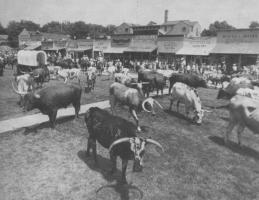
Many of the Butler steers were used on the Centennial Trail drive to Dodge City, 1966. |
When the TLBAA-sponsored sales started at Houston, San Antonio and Fort Worth, Milby consigned several cows to help out. It was hard for him to let go of his top cows.
Henry said, "He only consigned cows that were not as good as ones he kept. It really hurt to even think of letting go of the outstanding ones."
Once a vet came out to work with one of the cows and noticed several cows were completely smooth mouthed. He advised Milby to sell them for hamburger before they died of old age. Milby wouldn't even discuss it. He always thought as long as they were alive there was another chance for one more good calf. When a cow died Milby kept the skull. He cleaned them up so they were dry and bleached white. He wouldn't let go of a skull, either. The life history of every skull was quickly recalled to anyone genuinely interested.
At the time more TLBAA interest was springing up over the new breed registry, sales, etc., Milby eventually lost more and more interest in the good Brahman cattle, which once captured his fancy. Every bit of his enthusiasm turned to Longhorns.
Walter Osterman, currently of League City, said, "When I was a kid we used to help Milby with his cattle. He would have us kids gather the big-horned ones every so often and thoroughly rub lanolin into their horns. He wanted their horns healthy and shiny looking. If one nicked or splintered a horn, we were to rasp and sand it back down smooth so each appeared flawless."
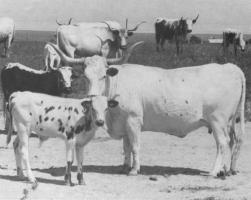
"Ghost" is typical of the bigger Butler cattle, weighing 1,200 in top conditions with 46" horns at age 11. Owner is Dickinson Ranch, Calhan, Col. |
Milby had some possibly "strange" ideas concerning selling his Longhorns. For years he said he wouldn't sell any, no matter what. If another Longhorn breeder wanted to buy a bull - none was available. Yet, to the contrary, he might just give away a pasture full if he liked you. Dewitt Michelle recalls several instances where he loaned out up to ten cows and a bull for several years. After a nucleus of calves was raised, the cattle would be returned and the borrower was well started in the Longhorn business.
J.G. (Jack) Phillips, Jr. recalls in 1951 receiving a call from a commission man who worked for Blue Ribbon Packing Co. at the Port City Stock Yards. Knowing Jack was working to accumulate top Longhorn blood, he told him of a big flat-horned bull that was at the yards consigned by Milby Butler. The bull was scheduled for slaughter. After the description Jack received, a deal was made to purchase the bull. Later, both Jack and Graves Peeler used the bull on their cows. He lived to a ripe old age, successfully eluding the ham burger grinder because of his rescue.
Months prior to the Phillips' purchase, Butlers had a chain-link lot prepared to hold and develop bulls. The fence was over eight feet high and rested on the ground attached to pipe posts. Milby kept all his possible herd sire prospects until they developed to make sure which ones would turn out to be an improvement to his cow herd. (The loaner bull program also allowed him to determine a bull's siring ability without risking an unproven bull on his best cows.)
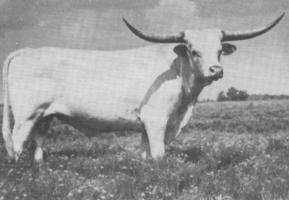
"Classic" is the longest horned bull currently certified over 40" by TLBAA. He is all Butler breeding. Horns are 60" tip-to-tip. Owner is F.M. Graves of Dayton, Texas. |
Each morning when Henry came to feed the bulls, one bull was always out of the pen grazing the greener grass. The job required bringing back a saddle horse, roping the bull and dragging him back to the pens. No big deal, really, just time consuming and aggravating after several days. This brown mottled bull had a mealy nose and lighter colored brown rings around each eye. He was a good candidate for a Butler herd sire but was becoming an increasing problem. From the first day the bull escaped, there seemed to be no place possible to exit. The fence was not stretched, no gates were open, no holes were possible, no signs showed where he had crawled under, and everyone knew he couldn't jump over eight feet. Everyone watched, to no avail, during the day for his escape method. After several weeks of an almost nightly escape, Henry decided to appoint one of the hands to sit up and watch his mysterious midnight method. After sundown when things had quieted down, the brown Houdini walked over to a favorite spot in the chain-link fence and proceeded to work on one post, then switch to another, raising the chain-link fence a half inch each time. After repeated unsuccessful times when the chain-link quickly slid back down the pipe post, the fence was finally raised on two posts six to eight inches. The bull patiently layed down flat on his side with back up against the raised fence. He eased one horn under the fence, followed by his nose and finally the other horn. At this point he vigorously kicked and pawed with all four feet until he pushed the fence up and went on under. After the skillful escape, the fence slid back down the smooth pipe posts, nearly touching the ground, just as if nothing ever happened.
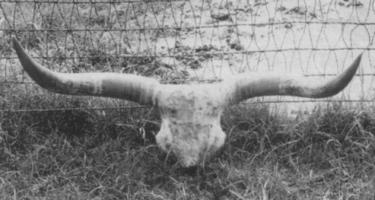
The skull of a Butler bull believed to measure 55" tip-to-tip. |
After viewing the masterly escape, a hasty decision was made to slaughter the bull, just on general principles. When Phillips purchased the bull, Milby was upset that his specific wishes were not carried out. Phillips reported, "I didn't have a lick of trouble with him. I put him out with the cows and he never gave any trouble. We raised a lot of cattle sired by him and he did us a lot of good."
The Butler cattle were branded  on the right upper hip and a TLBAA private herd number lower on the hip. This brand was registered in Galveston County, Texas by Milby's dad three generations ago. The cattle wearing this brand today are mostly teenagers or older. on the right upper hip and a TLBAA private herd number lower on the hip. This brand was registered in Galveston County, Texas by Milby's dad three generations ago. The cattle wearing this brand today are mostly teenagers or older.
Edwin Dow, an early TLBAA Director remembers contacts with the elderly Butler. 'He used to come to TLBAA meetings and sales. He was really quiet. We really had no idea he was raising a select group of Longhorns like the Butler cattle proved to be."

"Bold Ruler," a Butler bull, was selected to be used in 1976 on the Wichita Refuge for outcross Longhorn blood. His horns are over 49" at 4-years-old. The cow is WR 1850, a favorite of WR fans. |
Dewitt Michelle, who worked for Butler part-time during the 60's, described Milby's ideas on selective mating. "He had about seven pastures of Longhorns. Each cow was selected for that specific bull. Fences were built dividing his pastures that were virtually impossible for cattle to get out of. Certain bulls were mated to line breed certain blood lines. He had methods of obtaining percentages of certain blood lines then crossing them back on other lines within his herd."

This bull was a product of the Butler estate herd. In his later years Mr. Butler was not able to brand and keep TLBAA papers in order so this bull did not carry the OT brand. He was used by F.M. Graves. |
At the time of Milby's death in the early 70's, his cattle were very in bred. He searched for outside blood for 20 years that would not lose his huge-horned blood lines, yet give different genetics. With search after search, he didn't have the heart to allow a bull with his beloved cork screw horned females just for the sake of different blood. So, the herd continued on an intensive inbreeding course. Henry verifies this. "The older cattle were bigger than the Butler cattle today. The average bull, years ago would weigh 1,500 to 1,700 pounds. That's big in our Gulf Coast area. The horns aren't as big, either. Many of our old bulls and cows would measure 60 inches tip-to-tip."
When asked how many were raised and bred with the 60-inch horn proximity, the reply was 35 or 40 head during the Butler generations.
During the mid 60's, Garnet Brooks worked as inspector for TLBAA. He saw the Butler cattle on two different occasions. Because of Butler's poor health, it was very difficult to make contact with him. On the first inspection, Brooks was accompanied by Sam Partlow. Butler could not be found. Brooks' comments to TLBAA in his regular notes indicated the following: "The Butler cattle were mostly light colors of cream, dun, grulla and white speckled. I did not see any black cattle. The pastures were partly chain-link with excellent gates and working pens. There were many old cattle with the Texas twist- screw type horns. They were unusual cattle and different from other Long horn herds. They were a bigger framed cattle than most southeast Texas cattle. Many of the cattle could be considered real outstanding on horns."
At the time of the second inspection, some months later, Brooks went to Butler's home and picked him up. The elderly gentleman was very crippled and couldn't drive himself, but was still very excited about showing Brooks the cattle.
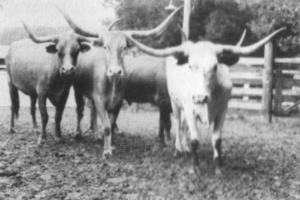
These eight-year-olds are all Butler steers owned by Ralph 0. Parker, 66 Ranch, League City, Texas. The white one has 66-inch horns. |
Brooks recalls, "Mr. Butler had been a big man. He was pleasant and kind to me even though I was sure he suffered much pain while I was there. Again we saw an identical type of twisted big-horn cattle. The cattle were very uniform. They were selected for a specific type of his own desire. He felt he had a true type of the old blood."
It is estimated that less than five percent of today's registered Long horns contain Butler blood. Many of the estate's cattle were sold for slaughter and dispersed to unknown parts. The complete history with its trials, victories, heartaches and tears will, for the most part, still remain unknown. Occasionally a bit of fact will be uncovered as evidenced by a skull or a scrap book photo weathered by age. Yet, from the history we have gleaned, one can appreciate a family whose untiring efforts included the annual excitement of planning the genetics of a calf crop better than the last.
Note: The Butler Cattle, by Darol Dickinson, was reprinted with permission from Texas Longhorn Journal, Winter, 1979.
|